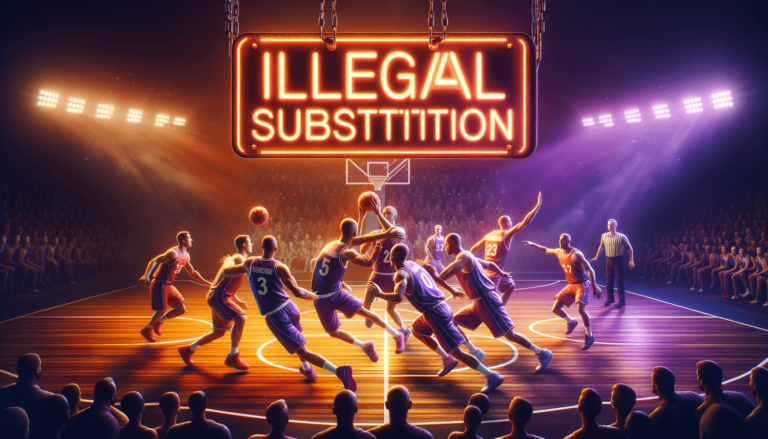
Illegal Substitution Rule in Basketball: How It Works
Written by: Basketball Universe
Last updated:

As the sounds of dribbling echo throughout the hardwood court and fans eagerly anticipate the next high-flying dunk or clutch three-pointer, the complexity of basketball often extends beyond the visible action. One such intricacy is the illegal substitution rule – a seemingly straightforward concept that has its fair share of nuances. Welcome, hoops enthusiasts, to our in-depth exploration of the mysterious world of illegal substitutions in basketball. In this post, we’ll unravel the rule’s intricacies, breeze through the nitty-gritty, and make sure you emerge a more knowledgeable fan, forever ready to impress your friends with your understanding of this critical aspect of the game. Buckle up, ballers!
Illegal Substitution Rule in Basketball: How It Works
Illegal substitution in basketball occurs when a player enters the game without properly reporting to the scorer’s table or during a disallowed moment. Proper reporting includes providing the player’s number and waiting for a dead ball situation before entering. If a substitution is attempted while the ball is in play, during a free-throw attempt, or without the officials’ acknowledgment, it results in a technical foul. The opposing team is then awarded two free throws and possession of the ball afterwards.
Understanding the Basics of Substitution
Before we dive headfirst into the world of illegal substitutions, it’s essential to understand the basics of basketball substitution. In basketball, five players represent each team on the court. However, the teams have additional members on the bench, waiting for their opportunity to jump into the action. As the game progresses, coaching staff strategically substitute players to manage fatigue, adjust team dynamics, or exploit opponents’ weaknesses. Substitutions are an integral part of the game and contribute to the intricate tactics used to secure that all-important win.
Proper Substitution Procedure
To ensure smooth gameplay and prevent any unfair advantage, the sport has established guidelines that dictate how a substitution should occur. Outlining the proper procedure helps avoid misunderstandings, confusion, or potentially controversial calls.
Step 1: Reporting to the Scorer’s Table
A player, usually with the coach’s approval, must first report to the scorer’s table and provide their jersey number. It’s important to communicate clearly with the officials at the table to avoid any mix-ups or transparency issues.
Step 2: Waiting for the Right Moment
After reporting to the scorer’s table, the incoming player must patiently wait for the correct game situation to legally enter the court. Adequate moments usually include:
- Dead ball situations (e.g., after a whistle or out-of-bounds call)
- During a timeout
- After a successful field goal
- At the beginning of a new quarter or overtime
Step 3: Gaining Official Acknowledgment
Once the right moment arrives, the incoming player can only enter the court after receiving the officials’ acknowledgment. The referee will signal the player it’s safe to swap with their teammate. The outgoing player must exit the court promptly as the new player enters.
When Substitutions Go Awry: The Illegal Substitution Rule
Like any human endeavor, mistakes happen, even in basketball. However, when it comes to substitutions, certain errors may result in an illegal substitution – and that’s where our beloved basketball rules come into play. Let’s demystify the illegal substitution rule and unveil what constitutes an incorrect player swap.
Scenario 1: Not Following Proper Reporting Etiquette
As we mentioned earlier, players are required to report to the scorer’s table and provide their jersey number before entering the court. If a player skips this important step, they may face an illegal substitution call from the officials. Remember, communication is key, and failing to inform the officials properly could lead to unwanted consequences.
Scenario 2: Substituting During Disallowed Moments
Another scenario in which an illegal substitution can occur is attempting to swap during an unsuitable moment, such as:
- While the ball is in play
- During a free-throw attempt (except when substituting for the shooter)
- Without the officials’ acknowledgment
Attempting to substitute during these disallowed moments could land your team in hot water and trigger the illegal substitution rule.
The Impact of an Illegal Substitution
So, what’s the big deal about illegal substitutions? Aside from it being against basketball rules, it comes with a few penalties that may put your team at a disadvantage.
Technical Foul and Free Throws
When an illegal substitution occurs, the opposing team is awarded a technical foul. This means they have the opportunity to shoot two free throws from the charity stripe. Each successful free throw adds a point to their score, potentially closing a narrow gap or increasing their lead.
Additional Possession
After the free throws, the opposing team also gains possession of the ball. This opportunity enables them to score even more points, further widening the gap in the game. Keeping the ball away from your opponents directly affects the outcome, so an illegal substitution might prove costly.
Avoiding Illegal Substitution Pitfalls
To keep your team on track and avoid the headache of illegal substitutions, consider these tips to help ensure you follow the proper protocol.
Maintain Clear Communication
Ensuring that everyone on the team – players and coaching staff alike – understands the proper substitution procedure is crucial. Creating an environment that prioritizes communication will minimize errors, maximizing your team’s potential on the court.
Know the Game’s Pacing
Players must be aware of the game’s pacing and the right moments when they can enter the court legally. Familiarizing oneself with these opportunities will help avoid illegal substitutions.
Respect the Referees
Remember, the referees are there to keep the game fair and flowing smoothly. Respecting their role and waiting for their acknowledgment before entering the court will go a long way in avoiding any rule-breaking scenarios, including illegal substitutions.
From Newcomers to Seasoned Veterans: Mastering the Art of Substitution
Regardless of whether you’re a newcomer to the sport or a seasoned basketball veteran, understanding the illegal substitution rule is essential. By observing the proper protocol, cooperating with officials and your team, and knowing the optimal moments for substitutions, you’ll be better prepared to enjoy the thrilling, fast-paced game that is basketball – sans technical fouls.
Notable Illegal Substitution Examples in Professional Basketball
Even in professional basketball, instances of illegal substitutions have occurred, leading to memorable in-game situations. These examples showcase the importance of following proper protocol during substitutions and highlight the impact these moments can have on game outcomes.
Malik Monk and Game Delay: March 2018
During an NBA game between the Charlotte Hornets and Brooklyn Nets in March 2018, a unique illegal substitution scenario arose. Malik Monk, a Hornets player, did not report to the scorer’s table before entering the game. As a result, the officials assessed a technical foul, and the Nets gained an additional point. Interestingly, this specific instance created enough confusion on the court that it led to a slight game delay.
A False Start: April 2010
In a 2010 NBA game between the Houston Rockets and Charlotte Bobcats, Rockets player Aaron Brooks received a technical foul when he tried to check into the game during a free-throw attempt. Since he hadn’t reported to the scorer’s table, his entry to the court prompted the officials to stop game play and call an illegal substitution technical foul.
Substitution Strategy: Maximizing Efficiency
While understanding and avoiding illegal substitutions is important, honing your substitution strategy can also make a significant difference in your team’s overall performance. Here are some factors to consider:
Player Stamina and Fatigue Management
One of the primary reasons for substituting players is to manage fatigue, allowing team members to rest and maintain their peak performance. Coaches must keep an eye on a player’s energy level and consider swapping them out as necessary to avoid excessive exhaustion.
Offensive and Defensive Balancing
Another essential aspect of substitution strategy involves balancing your offensive and defensive capabilities on the court. Consider making substitutions based on opposing team matchups, capitalizing on your team’s individual strengths and recognizing possible weaknesses that could be exploited by the opposition.
Encouraging Team Depth and Versatility
Experienced coaches excel at making the most of their teams’ depth and versatility. Bench players can provide much-needed energy and enthusiasm, so it’s crucial not to undervalue their contributions. By rotating players and fostering a culture of involvement, you can develop a robust team dynamic that values every member’s unique skills and contributions.
Conclusion: Embracing the Importance of Substitution Rules
At every level of basketball, from amateur play to the professional leagues, substitution rules are essential for ensuring fair competition and maintaining game flow. Familiarizing yourself with these guidelines will not only keep you in referees’ good graces, but it can also help your team avoid unnecessary penalties and setbacks. By mastering both the art and rules of substitution, you’ll be well-equipped to tackle any challenge the game presents, guiding your team towards success on the court.
Frequently Asked Questions: Illegal Substitution Rule in Basketball
For additional clarity, we’ve compiled a list of frequently asked questions related to the illegal substitution rule in basketball. Read on to find succinct answers to some of the most common queries about this fascinating topic in the world of hoops.
1. Can a player substitute during a free throw attempt?
A player can only substitute during a free throw attempt in specific situations, such as when the shooter is the player being substituted due to injury or disqualification. Substitution is not allowed during any other free throw attempts.
2. How do I know when it is legal to enter the game as a substitute?
It’s legal to enter the game as a substitute when the ball is deemed dead, during a timeout, after a successful field goal, or at the beginning of a quarters or overtime. Additionally, you must have reported your jersey number to the scorer’s table and received acknowledgment from the officials before entering.
3. If a player accidentally enters the court illegally without the official’s acknowledgement, what happens?
If a player accidentally enters without the official’s acknowledgment, they will be deemed to have made an illegal substitution, resulting in a technical foul. In this case, the opposing team gets awarded two free throws and possession of the ball.
4. Can the coach make a substitution without a player’s consent?
Yes, coaches have the authority to make substitutions, and their decisions typically supersede player preferences. Coaches strategically substitute players based on factors such as fatigue and game dynamics.
5. How does a referee signal a player to enter the game legally?
When it’s time for a player to enter the game legally, the referee will make a clear motion or signal, usually pointing towards the player or beckoning them onto the court.
6. Can a disqualified player re-enter the game?
No, a disqualified player cannot re-enter the game. Once a player has been disqualified (e.g., via fouling out or a technical disqualification), they must remain on the bench for the remainder of the game.
7. How many substitution opportunities are there during a basketball game?
Substitution opportunities are generally available whenever play stops, such as during dead ball situations, timeouts, and between quarters. There is no predetermined number of substitution opportunities during a basketball game, as it depends on the game’s flow and specific events.
8. Can a player be substituted for another player of the same position?
Yes, players of the same position can be substituted for each other. Substitutions are not limited by team positions but rather by a coach’s strategy and available roster.
9. Why do teams substitute players?
Teams substitute players to manage fatigue, adjust team dynamics, exploit opponents’ weaknesses, and respond to game situations. Substitutions allow players to rest and maintain optimal energy levels on the court while also enabling coaches to implement strategic adjustments.
10. Can an injured player return to the game after being substituted?
Yes, an injured player can return to the game after being substituted, provided they have recovered and been cleared by the team’s medical staff. The player must follow the proper substitution protocol when re-entering the game.
Featured Posts
- No pillar pages found.





